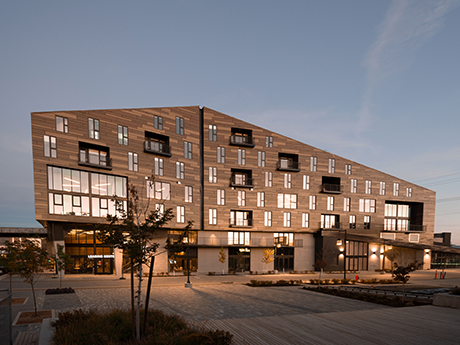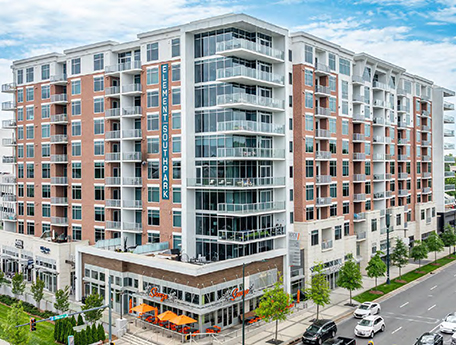By Joe Gose
Compare the dynamics of the multifamily debt environment of four years ago to today, and at first glance not much appears to have changed. A wave of capital ready for deployment? Check then and check now. The same can be said for the type of lenders active in the space: Life insurance companies, Fannie Mae and Freddie Mac, private credit sources, and banks were all hungry for deals back then and have a similar appetite today.
Of course, the economics have shifted dramatically. A spike in interest rates beginning in mid-2022 and declining property values followed a torrent of new construction starts and value-add plays launched during the height of the pandemic that were fueled by cheap debt. Consequently, the performance of the multifamily sector across the U.S. today is choppy. While annual rent growth on a percentage basis was in the teens or high single digits a few years ago, especially in the Sun Belt, it has flattened or declined due to overbuilding in several markets.
Nationally, the average vacancy rate in the second quarter of 2025 ticked up to 9 percent from 8.9 percent a year ago, according to Cushman & Wakefield. In the second quarter of 2022, the average vacancy rate in the U.S. was 5.7 percent.
As a result, a bid-ask spread that emerged during the run-up in interest rates continues to depress acquisition activity. Refinancings are fueling more business for lenders and financial intermediaries, but even those deals have been tempered by borrowers seeking loan extensions to avoid the potential of injecting more capital into a deal to secure replacement debt.

In June, Walker & Dunlop arranged a $170 million loan for a joint venture led by Bridge Investment Group
to refinance Post District, a mixed-use project in downtown Salt Lake City that includes 580 apartment units
and 26,000 square feet of retail space. Fannie Mae provided the debt via its near-stabilization program.
Image courtesy of Bridge Investment Group.
Additionally, the glut of new apartments has reduced construction lending. In 2025, for example, market-rate completions in the U.S. peaked at more than 520,000 units after rising from fewer than 310,000 units in 2019, according to Yardi Matrix, a research and property software firm based in Santa Barbara, California. Meanwhile, slackening demand for low-income housing tax credits is exacerbating a higher cost of debt for affordable developers (see sidebar).
Considering the fact that credit providers are eager to place capital, such a scenario could fuel a “race to the bottom” as lenders embrace more risk to compete, says Susan Mello, an executive vice president with Bethesda, Maryland-based intermediary Walker & Dunlop. But so far, underwriting remains disciplined, she reports.
“As I’ve talked to lenders, their deployment targets for this year are greater than last year, and I think they’re worried about putting their capital to work,” adds Mello, who heads Walker & Dunlop’s national capital markets platform. “They look at how much credit is out there and wonder how they are going to win deals in a way that makes sense and isn’t too risky.”
Unrealized Expectations
Sentiment within multifamily capital markets circles at the end of 2024 was that 2025 would mark a significant rebound in deal flow. However, sales of apartments during the first half of this year fell short of expectations, say industry experts. After a 41 percent increase in the first quarter from a year earlier, investment volume in the second quarter declined 14 percent year-over-year to $35.1 billion, according to MSCI Real Assets, a New York City-based commercial real estate researcher that tracks sales of $5 million and up. For the first six months of 2025, some $66.9 billion in assets traded hands during the period, a year-over-year increase of a modest 5 percent.
Uncertainty over absorption, interest rates, tariffs, job growth and other fears fueled some of the slowdown, mortgage professionals say. What’s more, buyers who initially assumed rent growth assumptions of 1 or 2 percent in the first year or two for a five-year loan have since dialed back those projections to zero or even negative rent growth, says Faron Thompson, senior vice president and regional managing director with Northmarq. In turn, that has re-widened the bid-ask spread between buyers and sellers that had narrowed somewhat, he adds.
This year, the spread between asking cap rates (what sellers are expecting) versus closing cap rates (what buyers accept) has, according to CBRE, increased to 20 basis points for core assets as of the second quarter. In the meantime, more selectivity among lenders is fueling bifurcation. Borrowers seeking financing for apartments that are older, in slow-growth markets or operationally challenged have fewer options than owners of properties that were built over the past 15 years and that are in favorable locations and possess stable fundamentals, observers say. Even among the more coveted assets, however, a proven sponsor can make or break a deal today compared with the frothy market four years ago.
“When the market is hot and everybody is making money, all lenders are alike — there’s almost a one-size-fits-all approach to the business,” says Thompson, who focuses on placing multifamily debt and equity from the firm’s Atlanta office. “But right now, lenders are very discriminate. They want to work with very established and seasoned sponsors.”
Similarly, buyers are also gravitating toward lenders that they’ve done business with in the past, observes Steve Fried, head of originations at Mesa West Capital, a Los Angeles-based debt fund focused on multifamily, hotels and commercial real estate. “In periods like this, where there is some volatility, you may have a business plan, but most likely things aren’t going to go according to plan,” says Fried. “In those situations, sponsors want to have a strong relationship with their lender.”
Bridging to Tomorrow
Indeed, many new projects funded with historically inexpensive debt have experienced longer-than-expected lease-up periods or are falling short of meeting their net operating income (NOI) projections. As a result, some sponsors can’t secure permanent financing without injecting additional equity. Nor can they agree on a price for a potential exit as many apartment buyers are hunting for deals under replacement value, says Matthew Wurtzebach, a senior vice president in the commercial financial group at Draper and Kramer, a Chicago-based commercial property and financial services firm.
Instead, multifamily sponsors are opting to borrow new short-term debt with the hope of bridging to better times. That’s creating opportunities for lenders, particularly debt funds and life insurance companies, points out Nate Sittema, vice chairman of CBRE’s debt and structured finance group.
“Pick a major market where you’ve seen more inventory built — Phoenix, Nashville, Charlotte or Atlanta — and the rents are still lower than what developers had projected, so the transaction activity hasn’t been there,” states Sittema, who is in CBRE’s Atlanta office. “Most of our business has been construction take-out loans for the purposes of getting to 18 to 24 months down the road when rents rally back given the falloff in future supply.”

Affinius Capital in July provided $340 million to Sky Equity Group to refinance 313 Bond, a 603-unit project that includes 51,600 square feet of retail space in the Gowanus neighborhood of Brooklyn, New York. The proceeds will be used to complete the project’s construction and leasing.
Image courtesy of Sky Equity Group.
While banks have returned to a more active lending role in the multifamily market over the past several months, they are much more conservative in today’s higher interest rate environment, say lending experts. Because apartment values have dipped, banks can’t dole out a sufficient amount of proceeds to take out construction loans they made in 2021 and 2022 for properties that have yet to hit their performance targets, explains Michael Lavipour, head of lending at Affinius Capital, a private credit firm based in New York. According to Freddie Mac’s 2025 Multifamily Outlook, property prices have been declining for nine consecutive quarters since their peak in mid-2022 and are down by approximately 20 percent since then.
For its part, Affinius is hunting for opportunities to make higher leverage loans and then offer banks a piece of the debt as part of a “back leverage” play, he adds, in which debt funds borrow from third parties to finance their loans. The arrangement also allows banks to still participate in deals.
In July, Affinius provided $340 million in refinancing to Sky Equity Group to complete the remaining construction and leasing of 313 Bond, a 603-unit project with 51,600-square-feet of retail space in Brooklyn.
“We are very focused on newly built product because we don’t see a lot of new construction and supply going forward, and there’s still a housing shortage in the U.S.,” he declares. “The newest projects today will still be the newest projects in a couple of years, and they should see rent and cash flow growth when it’s time to refinance our loans.”
Judicious Wagers
Affinius remains bullish on certain markets even though they may be experiencing a glut of supply at the moment, says Lavipour. Cities like Nashville and Austin, for example, experienced respective rent rate declines of 2.5 percent and 7.2 percent in the second quarter from a year earlier, according to CBRE’s latest apartment report. “We’ll be conservative in our lending levels,” he remarks, “but those are good long-term fundamental markets that just need to see absorption.”
Mesa West is taking the same approach. In August, it provided a $52 million short-term, floating-rate loan to refinance Canyon Reserve, a 256-unit garden-style community built in the 1980s in suburban Denver. While CBRE reports that rents in metro Denver declined 4.8 percent in the second quarter from the previous year, Mesa West pointed out that the sponsor had fully repositioned the asset in 2022.
“We’re being a little bit more careful about older vintage properties while looking for infill opportunities,” says Fried. “It’s about selecting the assets and business plans that you can get behind.”
Fannie Mae and Freddie Mac are also frontrunning expected fundamental improvements by funding some projects near stabilization, reports Mello. In June, Walker & Dunlop arranged a $170 million Fannie Mae loan to refinance Post District, a mixed-use project that includes 580 apartment units and 26,000 square feet of retail space in downtown Salt Lake City. Still, such near-stabilized executions are limited compared with those completed by private lenders, she adds.
“In the bridge loan space, some lenders are refinancing construction loans even before there’s a certificate of occupancy or in projects that are 10 or 20 percent leased,” says Mello. “The agencies can’t play in that space.”
Sales Turnaround Near?
Looking ahead, mortgage professionals expect refinancings to increase as five- and 10-year fixed-rate loan maturities tick up through 2029, says Wurtzebach. But sales volume is the real driver of the loan origination business, he asserts, and the waiting game for a rebound in property trades continues.
“We need a combination of continued NOI growth and a contraction in interest rates to get that engine running,” he says. “But the risk of inflation and higher Treasury rates keeps us up at night.”
Despite potential economic disruptions, intermediaries and lenders are optimistic that sales will pick up in the second half of 2025. The benchmark U.S. 10-year Treasury has generally been trading between 4.2 and 4.5 percent since February, for example, which is an improvement over the more volatile yield movements in 2024.
It’s also a more realistic level than the sub-2 percent rates that that began in mid-2019 and lasted until early 2022, observers acknowledge. On Sept. 17, the Federal Reserve reduced the federal funds rate by 25 basis points to a target range of 4 to 4.25 percent. After the Consumer Price Index rose 2.9 percent in August, however, additional rate cuts this year may be tempered by rising inflation.
Moreover, modest interest-rate spreads that ballooned higher by some 30 basis points or more on President Trump’s tariff rollout in early April, dubbed “Liberation Day,” resettled at their previous levels soon after, experts report. Today, spreads at banks range from around 150 to 160 basis points above the U.S. 10-year Treasury yield, and spreads at life insurance companies range from 160 to 180 basis points for loans of about 60 to 65 percent of value, Thompson says.
Debt funds will move up the leverage scale for a price. Mesa West charges between 250 to 325 basis points over the secured overnight financing rate (SOFR), depending on the asset, loan-to-value ratio, cash flow, location, sponsor and other deal characteristics. As of early September, SOFR was around 4.4 percent.
Meanwhile, cap rates have largely stabilized to an average of 5.7 percent as of the end of July, according to MSCI Real Assets. That’s well above the average sub-5 percent range for much of 2021 and 2022, but it is still below its long-term norm, the research organization notes.
Additional signs of confidence include CBRE’s latest cap rate survey, which found investors were most bullish about multifamily investment returns over the next decade versus other property segments.
What’s more, in 2024 borrowers were frequently opting for five-year, fixed-rate term loans to lock in a lower cost of capital relative to SOFR and the U.S. 10-Year Treasury bond and to avoid potential spikes in the floating-rate market, says Sittema. Today, borrowers are gravitating toward short-term, floating-rate debt to be able to more quickly pivot in an improving environment.
“There’s a belief that we’re close to a return to normal, and we’re advising folks to have flexibility for whatever comes next — fundamentals returning to strong levels, the falloff in supply giving way to significant rent growth, or a cut or two in the federal funds rate that allows you to borrow a lot cheaper,” he explains. “Any one of those three things could move the needle, and it would be prudent to be prepared.”
This article originally appeared in the September print issue of Multifamily & Affordable Housing Business.


